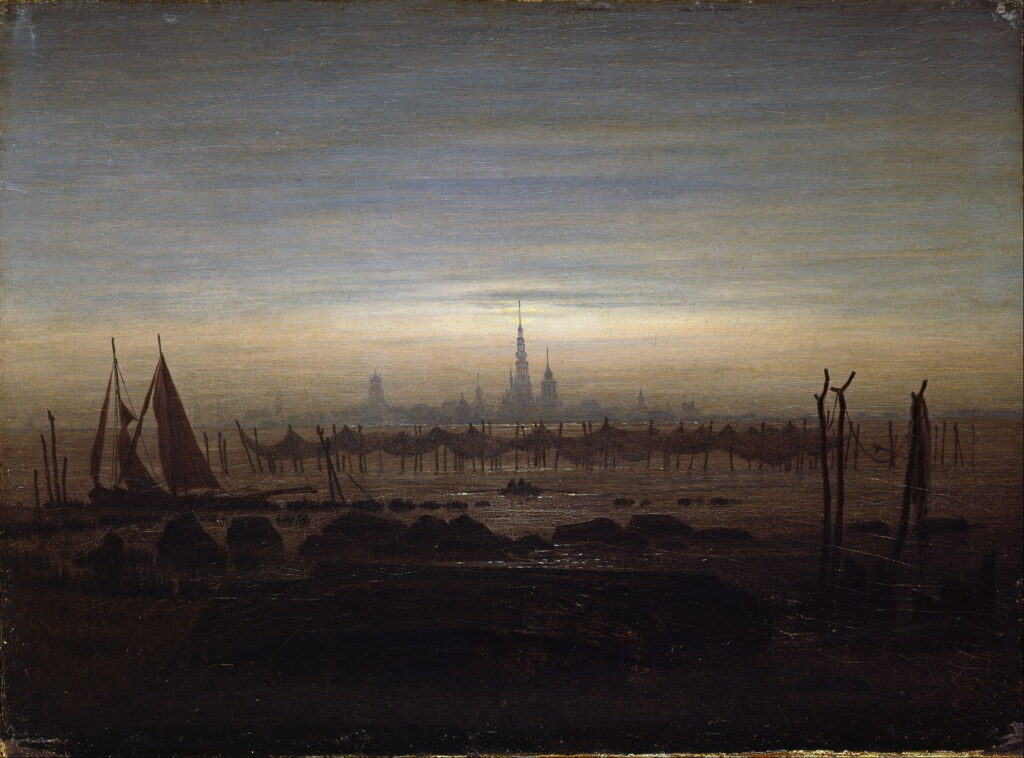Sea of Mists: German Romantic painters

This series of articles looks at the German Romantic painters, their influences, paintings, and those that they influenced. This article provides a brief overview with links to each of the individual articles in this series.
Influences
Claude-Joseph Vernet (1714–1789), Seaport by Moonlight (c 1771), oil on canvas, 98 x 164 cm, Musée du Louvre, Paris. Wikimedia Commons.
Claude-Joseph Vernet (1714–1789), senior member of a family of French painters, a prolific landscape and marine artist who spent much of his career in Rome.
Caspar Wolf (1735–1783), a pioneering Swiss landscape artist who specialised in painting views of the Alps.
Philip James de Loutherbourg (1740-1812) initially specialised in dramatic landscapes and marines, before moving from France to London.
Henry Fuseli (1741–1825), another Swiss artist who settled in London, where he served as the Royal Academy’s Professor of Painting from 1799.
Influences on Caspar David Friedrich and Romantics
The German Romantics
Caspar David Friedrich (1774–1840)
Caspar David Friedrich (1774–1840), Die Lebensstufen (Strandbild, Strandszene in Wiek) (The Stages of Life) (1834-5), oil on canvas, 72.5 x 94 cm, Museum der bildenden Künste, Leipzig. Wikimedia Commons.
Born near the Baltic coast of modern Germany when it was part of Swedish Pomerania, and lived for most of his adult life in the city of Dresden.
He studied at the Copenhagen Academy, then moved to Dresden in 1798, from where he travelled to sketch on the Baltic Coast, on Rügen, in the Harz Mountains, and Bohemia. He met Philipp Otto Runge, then in 1815 was elected to the Dresden Academy. Two years later, he met Carl Gustav Carus, and JC Dahl, both of whom become his pupils and lifelong friends. In 1824, he was appointed professor at the Dresden Academy. Leader of the German Romantic painters.
Caspar David Friedrich to 1820
Caspar David Friedrich 1820-30
Caspar David Friedrich 1830-40
Carl Gustav Carus (1789–1869)
Carl Gustav Carus (1789–1869), View of Dresden at Sunset (c 1822), oil on canvas, 22 x 30.5 cm, Kunstsammlungen Chemnitz, Chemnitz, Germany. Wikimedia Commons.
Pupil of Caspar David Friedrich, a brilliant progeny and polymath. He was appointed professor of obstetrics in Dresden at the age of 25. Initially an amateur artist, he became friends with Friedrich, who taught him to paint in oils between 1814-17. Carus went on to research in botany, zoology and psychology. He was also a friend of and influence on Goethe.
Carl Gustav Carus 1816-25
Carl Gustav Carus 1826-50
Johan Christian Dahl (1788–1857)
Johan Christian Dahl (1788–1857), Danish Winter Landscape with Dolmen (1838), oil on canvas, 38 x 50 cm, Nasjonalmuseet for kunst, arkitektur og design, Oslo, Norway. Wikimedia Commons.
Known as JC Dahl, from Bergen, Norway, he studied at the Royal Academy in Copenhagen, where he established himself as a prolific and capable realist landscape painter, which brought him to Friedrich in Dresden in 1818. He visited Italy in 1820, then in 1823 he and his family moved in with Friedrich and his family, when they both taught in Dresden. His pupils included the Norwegian landscape artists Peder Balke and Thomas Fearnley.
JC Dahl 1818-1827
JC Dahl 1829-1856
Philipp Otto Runge (1777–1810)
A promising painter who was also born in Swedish Pomerania. He studied at the Copenhagen Academy, then moved to Dresden in 1801, where he later became involved in the Romantic Movement and became friends with Friedrich. He developed a colour model based on a sphere, but died of tuberculosis in 1810, when he was only 33.
Carl Friedrich Lessing (1808–1880)
Carl Friedrich Lessing (1808–1880), Rocky Landscape, Gorge with Ruin (date not known), media and dimensions not known, Städelsches Kunstinstitut und Städtische Galerie, Frankfurt, Germany. Image © José Luiz Bernardes Ribeiro, via Wikimedia Commons.
Born in what is now Wrocław in Poland, he trained at the Academy of Art in Berlin, then moved to the Düsseldorf Academy of Arts in 1826, where he became a member of the Düsseldorf ‘School’ of Painting.
Carl Friedrich Lessing 1828-36
Carl Friedrich Lessing 1837-78
Themes
Caspar David Friedrich (1774–1840), Wanderer above the Sea of Mists (1818), oil on canvas, 94.8 × 74.8 cm, Kunsthalle Hamburg. Wikimedia Commons.
A characteristic if not distinctive theme in German Romantic paintings are figures that are looking away from the viewer into the landscape, so showing their back, hence in German Rückenfigur, ‘back-figure’. These feature in the paintings of most of these artists.
Rückenfigur
Nocturnes
Ships
Barren trees
Other common themes
Pupils
Peder Balke (1804–1887)
A Norwegian and a pupil of JC Dahl in Dresden, he trained at the art academy in Stockholm, Sweden. When still a student in the summer of 1830, he walked through the mountains in Telemark to Bergen, then back to Hallingdal, sketching for later paintings. In 1832 he toured Finnmark in much the same way, which inspired him to paint the remote coast of northern Norway, including North Cape.
Thomas Fearnley (1802–1842)
Thomas Fearnley (1802–1842), Old Birch Tree at Sognefjord (1839), oil on canvas, 54.5 x 66 cm, Nasjonalgalleriet, Oslo. Wikimedia Commons.
Born in south-east Norway, he trained at the Norwegian National Academy of Craft, the Art Academy in Copenhagen, then in its sister academy in Stockholm. In 1828 he went to Germany, and the following year became a student of JC Dahl in Dresden. When in Munich early in 1842, he died of typhoid when he was only 39.
Thomas Fearnley 1
Thomas Fearnley 2
Knud Andreassen Baade (1808–1879)
Born on the coast of south-west Norway, he trained at the Royal Danish Academy in Copenhagen. He went to Dresden in 1836 to be taught by JC Dahl, and became influenced by Friedrich.
Influenced
Arnold Böcklin (1827–1901)
Arnold Böcklin (1827–1901), Island of the Dead (version 3) (1883), oil on panel, 80 x 150 cm, Alte Nationalgalerie, Berlin. Wikimedia Commons.
Born in Basel, Switzerland, he studied at the Düsseldorf Academy, then became a major Swiss painter.
Arnold Böcklin 1
Arnold Böcklin 2
Arkhyp Kuindzhi (1841-1910)
A Pontic Greek painter from Mariupol in the far south-east of Ukraine, he initially studied in the Crimean studio of the great marine artist Ivan Aivazovsky. Later studied at the Imperial Academy in Saint Petersburg, where he joined the Wanderers (Peredvizhniki). He enjoyed early success in selling paintings to Pavel Tretyakov, and returned to Ukraine throughout his career to paint its landscapes.
Hans Gude (1825–1903)
Born and initially educated in Christiania (now Oslo, Norway), he studied at the Academy of Art in Düsseldorf, Germany. On completion he returned to Norway where he became one of the founding fathers of Norwegian landscape painting.
Adolph Tidemand (1814–1876) & Hans Gude (1825–1903), Lystring på Krøderen (Fishing with a Harpoon) (1851), oil on canvas, 115 × 159 cm, Nasjonalgalleriet, Oslo. Wikimedia Commons.




